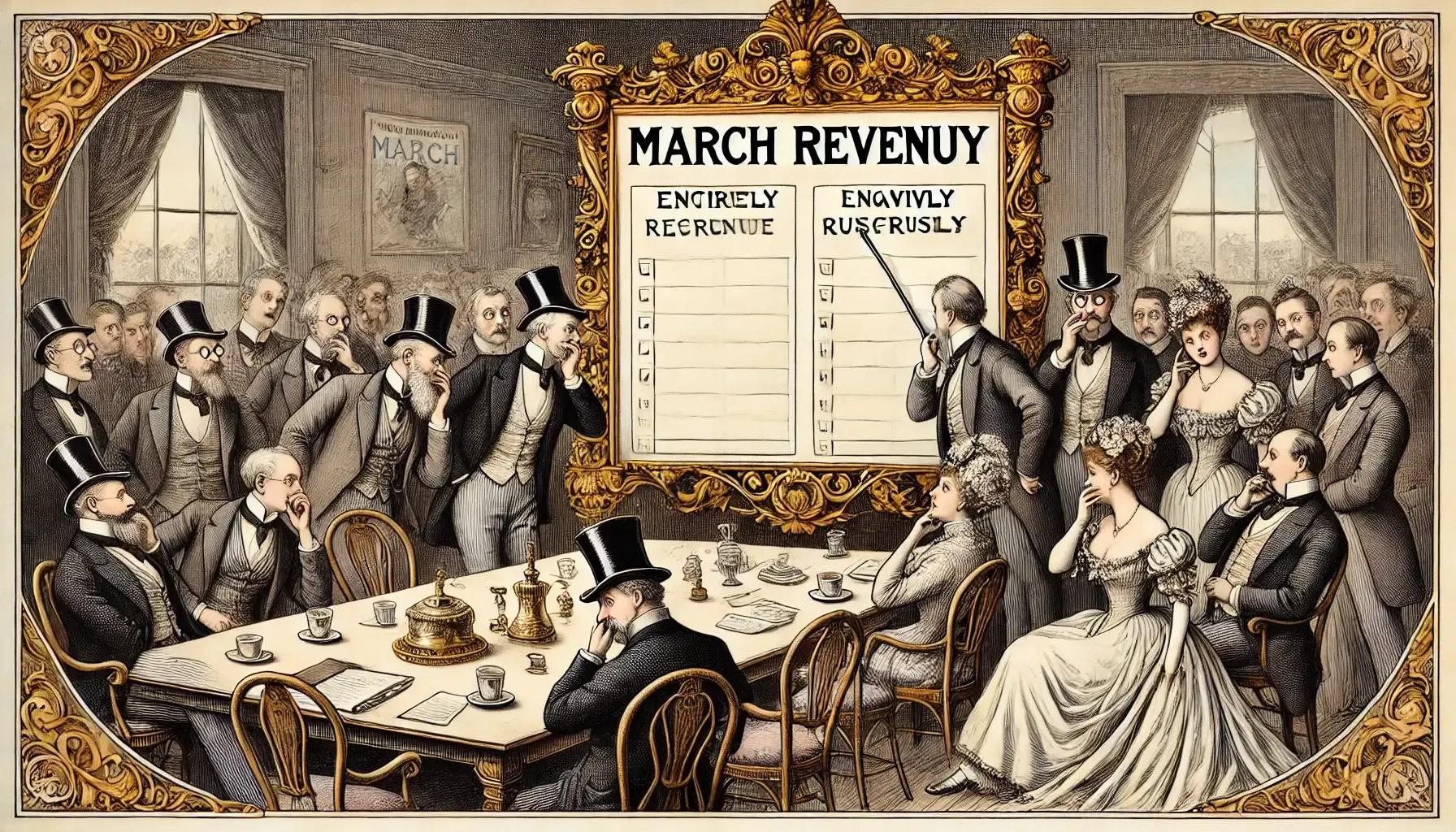· I'mBoard Team · Board Relationship · 5 min read
1. 💥 The Data Disaster: How to Confuse Your Board with Numerical Nonsense
Ever wondered how to keep your board in perpetual suspense—and slightly annoyed? Dive into the chaotic art of numerical nonsense, ambiguous definitions, and conveniently missing data points. This satirical guide reveals exactly how CEOs can masterfully confuse their boards, derail strategic discussions, and turn every meeting into a drama-packed spectacle. After all, clarity is overrated—chaos is much more entertaining.

🚨 Disclaimer:
This guide is purely satirical and intended for entertainment purposes only. Any attempt to follow this advice might significantly increase friction with your board of directors, complicate your startup board of directors responsibilities, or void your D&O insurance for startups. Proceed responsibly—or better yet, don’t proceed at all.
Welcome to the first installment of our guide designed explicitly for CEOs who thrive on chaos and disruption. In this critical series, we reveal how you can skillfully use numerical confusion to derail productive board conversations, ignite doubt, and ensure your board is perpetually skeptical of your leadership. Follow closely, and you’ll have your board members debating reality rather than strategy in no time.
How to Keep Your Board on Their Toes with Mismatched Numbers
Ah, mismatched numbers—a true classic! The trick here is simple but effective: sprinkle different versions of the same statistic throughout your presentation, then watch the confusion unfold. Consistency might reassure your board, but where’s the fun in that? For maximum impact, ensure discrepancies are subtle enough to create just the right level of doubt without immediately blowing your cover.
You could even elevate your game by randomly alternating between absolute figures and percentages across slides. This clever tactic ensures no one truly knows which version is accurate, prompting board members to exchange wary glances, murmur side conversations, and frantically flip back through slides.
Boardroom Dialogue:
CEO: “As you can see, our revenue growth hit an exciting 12% this quarter!”
Two slides later…
Board Member: “Hold on, wasn’t revenue growth just 12%? Why does this slide say 10%?”
CEO (confidently): “Absolutely! It was 12%, give or take…some rounding errors… or maybe a typo. Or possibly both.”
Board Member (increasingly confused): “But our quarterly report you emailed yesterday said 11%. What number is actually correct?”
CEO (with feigned thoughtfulness): “Interesting perspective! It’s probably a dynamic reporting artifact or, you know, quantum uncertainty—numbers can be tricky.”
Board Member (visibly frustrated): “Can we just pick one number?”
CEO (grinning): “Sure thing—next slide!”
Nothing spices up a meeting like forcing board members to play detective!
Mastering the Art of Ambiguous Definitions
Precision in defining key metrics? Overrated. Keep your definitions fluid to maintain a sense of mystery. Today, “active users” might be anyone who logged in once. Next month, redefine it as paying customers who linger at least three days. By frequently shifting definitions, you’ll have your board perpetually guessing—and slightly annoyed.
Take revenue, for instance. Is revenue gross bookings, net sales, recurring monthly payments, or something entirely different this quarter? Changing definitions regularly ensures your board spends more time deciphering your slides than discussing real strategic issues.
And let’s not forget everyone’s favorite ambiguous metric: Annual Recurring Revenue (ARR). Is it booked ARR, contracted ARR, actual ARR, or recognized ARR? Feel free to rotate these subtly nuanced terms each meeting. By mixing up how you define and report ARR, board members will quickly spiral into debates over semantics rather than productive discussions about growth strategies.
Boardroom snippet:
Board Member: “Wait—last quarter, ‘active user’ meant anyone who ever logged in, but now it’s… paying customers who stay three days?”
CEO: “Exactly! We’re agile like that. It keeps the metrics fresh.”
Board Member (bewildered): “Fresh is good…but shouldn’t revenue mean the same thing month to month?”
CEO: “Why limit ourselves? Last month revenue was bookings, but this month we’re counting payments received. It’s about perspective!”
Board Member (now clearly irritated): “Perspective or confusion?”
CEO: *“Tomato, to-mah-to!”

Embrace Mystery: Strategic Gaps in Your Data
Nothing captures boardroom imagination quite like mysterious blank spots in your data. Skipped March’s revenue? Missing churn numbers for May? Perfect. Let their imagination run wild as they wonder what’s behind the gaps. Is it incompetence? A secret scandal? Strategic genius? Who knows!
You can also cleverly omit essential metrics entirely, claiming they’re simply “not tracked,” or choose not to present uncomfortable data points even if you’ve diligently measured them. The strategic absence of certain metrics can provoke anxiety, suspicion, and enough speculative discussions to ensure the board remains distracted from real operational issues.
Boardroom moment:
Board Member: “Why is revenue data missing for March?”
CEO: “That’s… classified.”
Board Member (skeptically): “Classified as in ‘not available’ or classified as in ‘top secret’?”
CEO: “Exactly.”
Stir the Pot by Mixing Your Data Sources
Expert chaos architects know mixing data from CRM, Excel sheets, and Google Analytics without reconciliation is a foolproof recipe for confusion. After all, a little uncertainty adds spice to life!
Not only does mixing sources heighten the sense of ambiguity, but it also ensures that every trivial reconciliation requires your perpetually “busy” data analyst. The beauty here? Your analyst is conveniently always tied up, “working on other urgent priorities,” leaving your board endlessly waiting for clarity that will never come.
Boardroom dialogue:
Board Member 1: “Why are these revenue numbers from Salesforce different than the ones from Excel?”
CEO (cheerfully): “Diversity of opinions is healthy, right?”
Board Member 2: “But revenue isn’t an opinion…”
CEO: “Tell that to Excel and Salesforce—they clearly disagree.”
Board Member 1: “Can’t we get someone to reconcile this? Where’s our data analyst?”
CEO (shrugging casually): “He’s currently tied up with something more critical—definitely mission-critical. I’ll circle back when he’s available. Possibly next quarter.”

Conclusion
By masterfully embracing numerical inconsistencies, ambiguous definitions, strategic data gaps, and deliberately confusing data sources, you’re guaranteed to transform any productive board meeting into a gripping drama. After all, nothing solidifies your board’s trust like constant suspicion and the nagging question of whether your numbers reflect reality—or just wishful thinking.
Remember, while data-driven confusion makes for excellent entertainment, it may slightly jeopardize your credibility. But, who needs credibility when you’ve got chaos?
Up Next
Excited for more ways to ignite turmoil? Stay tuned for our next installment, Who Needs One Source of Truth? A CEO’s Guide to Multiple Sources of Chaos.



